Estimated reading time: 6 minutes
Have you seen these slugs on your fruit tree leaves? Every year we hear from gardeners who worry that these creepy-looking pests are attacking their fruit trees.
Getting rid of pear and cherry slugs
These are pear and cherry slugs, and as the name suggests, they eat the leaves on pear and cherry trees. On our farm, we’ve also seen slug damage on young plum trees at times, but it’s unusual.
The slugs look terrible, and so does the damage they cause, as you can see below.
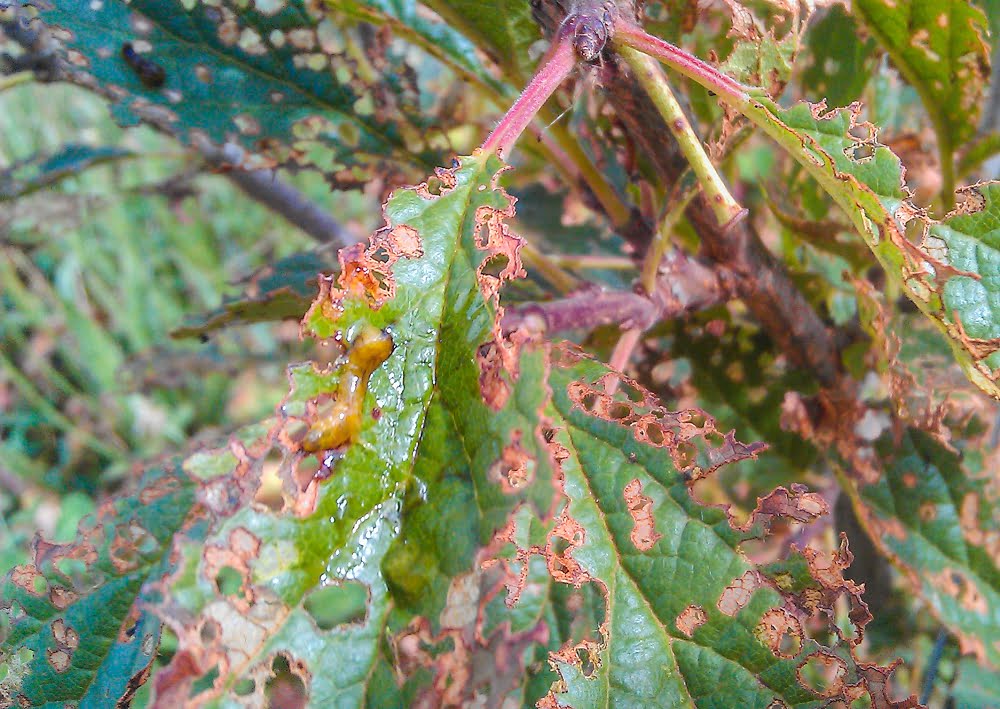
Despite that, they are definitely not one of the worst pests you need to worry about. Certainly not as bad as fruit fly, for example, which is a key pest you need to learn how to manage.
Monitoring your trees for slugs can help
The first thing you’ll often notice is the damage to your fruit tree, rather than the slugs themselves.
You might notice that the leaves start to look lacy. The slugs eat the green part of the leaves between the veins, leaving the network of veins behind.
In a bad case, they may also eat the veins, which leads to brown holes and missing parts of leaves (as you can see above).
The first question to ask yourself when you see these slimy slugs (as with all pests and diseases on your fruit trees) is, how much damage are they really doing?
Fruit trees can actually tolerate quite a bit of damage without losing function or growth.
At Grow Great Fruit HQ our rule of thumb is that if a tree has lost more than 30% of its leaves to slug damage, that’s the trigger to treat them. We never use sprays unless we have to, but there is an organic spray available.
In all our years of growing, we’ve closely monitored every year, and never had to spray them.
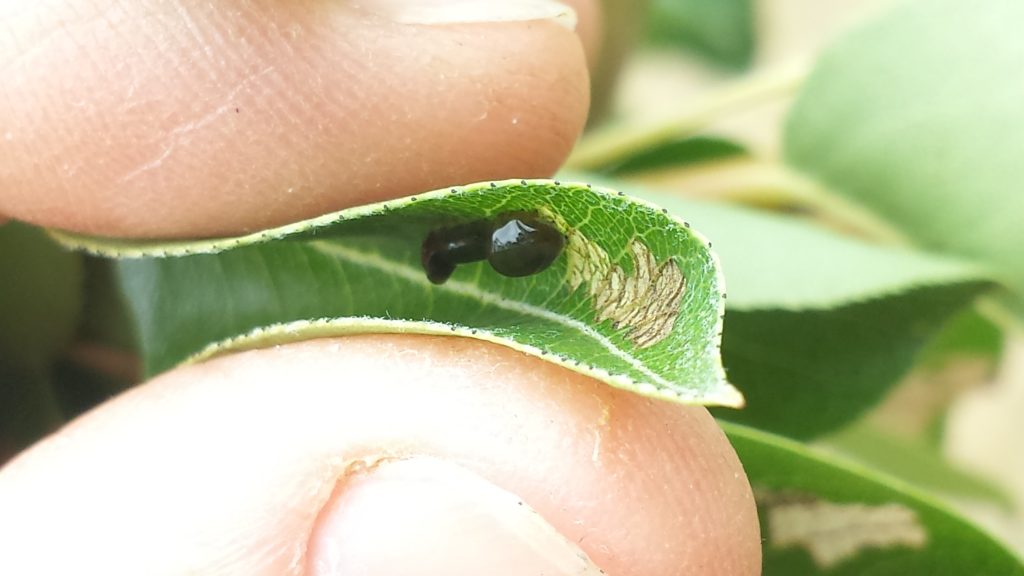
Simple but effective pear and cherry slug control
One of the advantages of keeping a close eye on your trees is that you will often notice problems as soon as they occur. You can then take simple action, like squashing the slugs between a folded leaf.
In a normal season this particular pest will go through at least two life cycles.
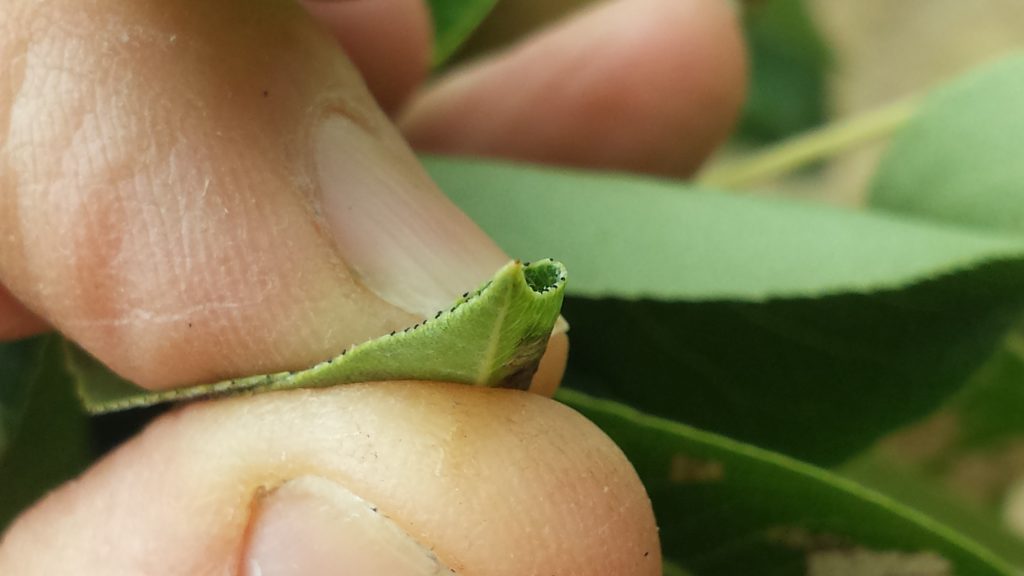
The more of them you squash as soon as you see them, the more you interfere with their natural life cycle. This will help to prevent numbers from building up.
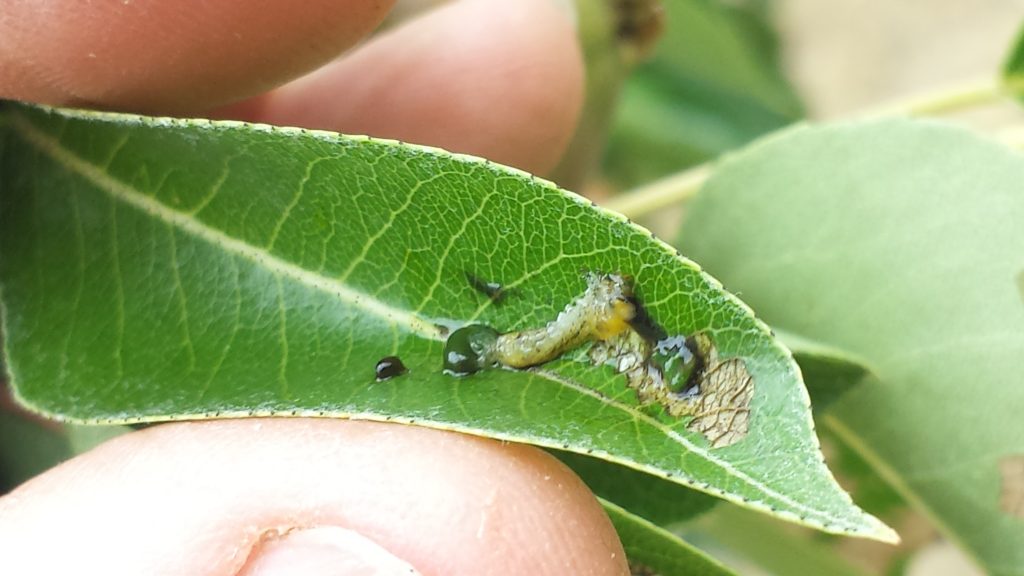
Usually, you will find that if you are patient, a predator insect will come along and do your work for you.
A dry, parasitised slug on the leaf is the classic calling card, as you can see in the photo below.
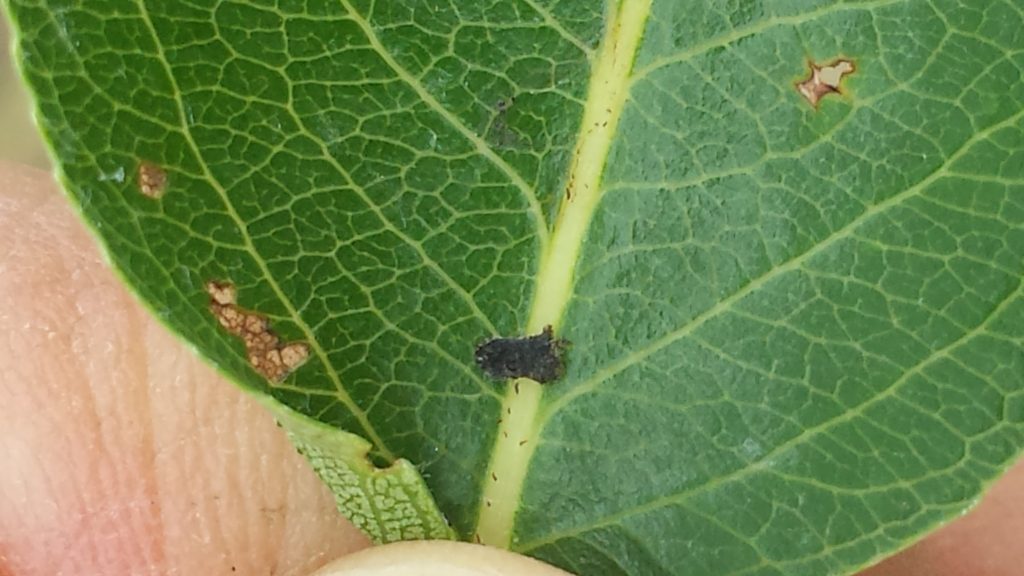
Other control techniques
If the slugs get away from you and there are too many to squash by hand, you may have to try another technique.
Being moist-bodied, they’re very vulnerable to being covered by anything dry and dusty. There are a number of treatment options available to control a slug outbreak. For example, flour, wood ash or sulphur are three products in your potential toolbox that are relatively easy to access.
Whatever you use, it’s important to stand upwind and make sure you don’t inhale it. One of our Grow Great Fruit junior members is perfectly demonstrating the technique in the photo below.
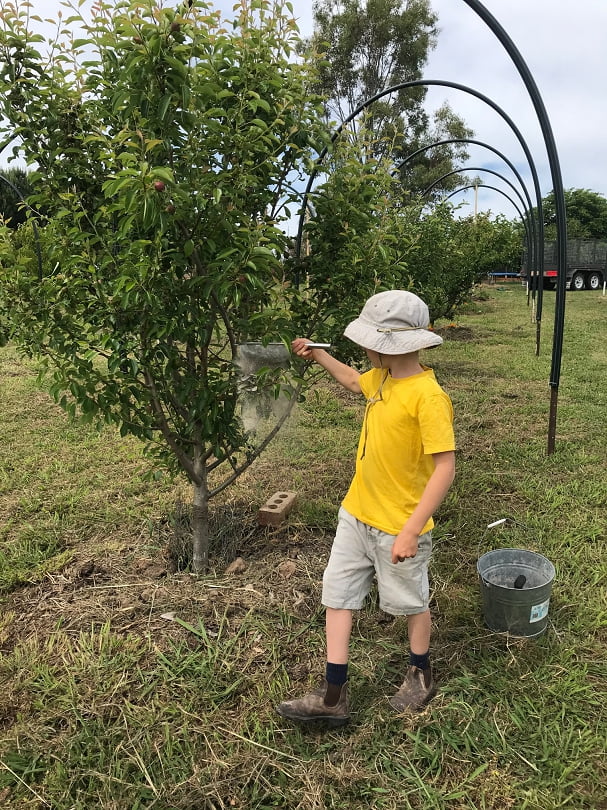
So pear and cherry slug is an excellent example of learning how to watch your fruit trees.
Particularly keep an eye on the leaves. If you see some damage, dig deeper to learn what’s really going on, rather than assuming that if there’s a bug, there’s a problem!
Related Articles
How to make and use a fruit picking diary
Using a fruit-picking diary can help solve the problem of choosing the exact time to pick your fruit so it’s neither under-ripe nor over-ripe.
Why you should pick up fruit from the ground
Picking up your fruit from the ground is the first principle of organic orchard hygiene, and one of your best lines of defence against pests.
Netting fruit trees made simple for backyard growers
The sooner you net your fruit trees, the sooner you’ll get reliable crops. We explain the different systems to help you choose the right one.

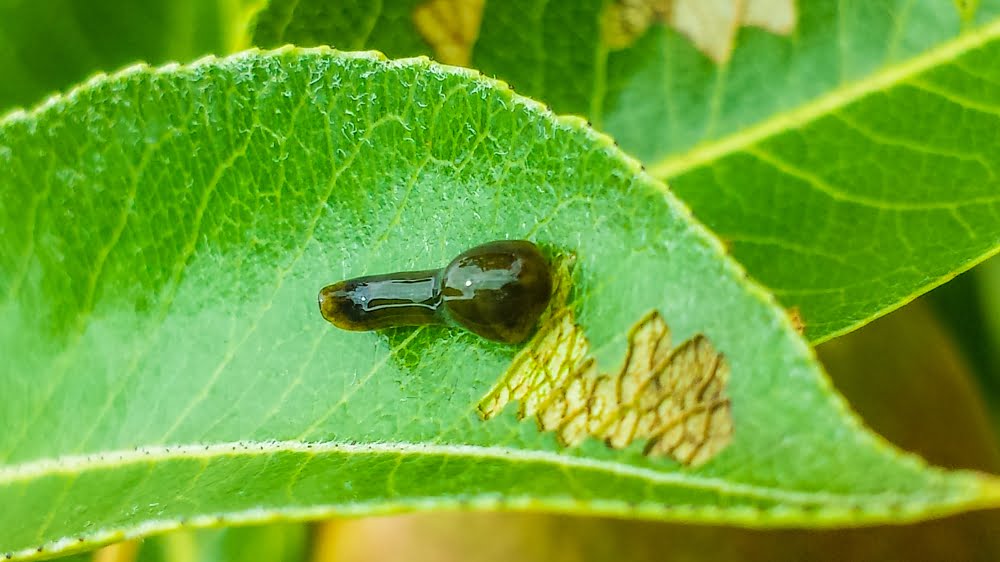

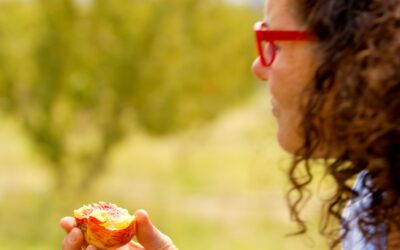
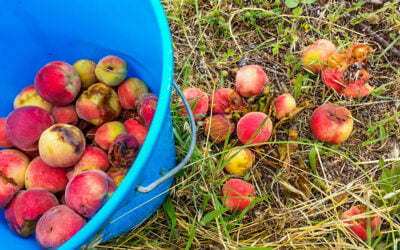



hi, I have cherry slugs each year on my pear tree and squash as I can, however, when they get really numerous I’ve found tossing handfuls of wood ash on the tree most effective as it appears to kill the slugs on contact with no harm to the tree. Thanks for your great tips and really good photos.
Hi Debby, thanks for the appreciation, we’re glad you’re enjoying the posts. Good tip about the wood ash, it’s one of the things we recommend so glad to hear it’s working well for you. Katie and Hugh
Hi, this is my first year growing pears and they have already been attacked by these slugs! Thank you for your well timed article. I now know what I need to do.
That’s excellent to hear Jen!
Haven’t had them for a few years, but appreciate knowing what to do if I have a problem again. Thanks.
Glad it’s useful Anne, thanks for taking the time to let us know.
Thank you for your always great tips! I have learned a lot this year.
Regarding the slugs (yes, I do have them on my cherry tree each year- nowhere near 30%): is there actually a way of not getting them? Still haven’t quite understood, where they come from…
Hi B, nope sorry – we don’t have any idea how to not get them. If someone could solve that problem, they’d be very rich! They mysteriously just come from the environment….
Hi are there any methods to control slugs with companion plants or other ways. Squashing then is an option but time poor at the moment. Thanks
Great clear pics and advice – thanks!
Our pleasure Eliza, glad you’re enjoying the info!
Can I use talcum powder?
Can I use talcum powder?
Hi Jay – there’s no good reason why not as talcum powder is usually made of talc, a mineral made mainly of magnesium and silicon. However, there have been concerns about asbestos contamination (unlikely) and they’ve often also got artificial fragrance in them. Also – it’s quite expensive. Cheaper alternatives would be either ash from a fire or sulphur.
Hi – I have the same condition on my plum, pear and Cherry trees. I spoke to a local arborist who identified the issue as pear and Cherry slug, and recommended a mixture of garden lime and water with a drop detergent sprayed over the ttrees.
Hi Dave, yes they’re everywhere this year. We haven’t heard of that solution before, so would be interested to hear how it goes. All the best with your trees.
I have them on my plum tree and they are damaging the leaves quite bad. Will this cause the tree to drop all its fruit when the plum get to the size of a cherry? If not, do you have any idea what could cause this to happen?
Hi John, that definitely does sound like pear & cherry slug. Have you noticed this happening to your fruit already? It’s definitely possible that the slugs are contributing to fruit drop if the tree is really stressed from it but there could also be other reasons for fruit drop (pollination, temperature, watering) so look out for that too. Thanks, Meg – Grow Great Fruit team.
Has anyone have any thoughts on diatomaceous earth to rid the sluggies
Gday Mick, diatomaceous earth can definitely work, and can provide some long-term protection too. Some people have success with kaolin clay. But, you’d need quite a lot for a whole tree, so probably more suited to smaller orchards and smaller trees. It cab be quite expensive compared with wood ash from your fire, but definitely an option! Meg – Grow Great Fruit team.
I thought I used vinegar and water on them last year. Is that an ok treatment, and what mix?
Hi CJ, Did you use vinegar and water and apply to the leaves? We would suggest choosing a sulphur product or using wood ash instead. Certainly spraying vinegar on the leaves could do more harm than good (by causing burning to the leaves) and you might be better off just hosing them off. Good luck, Meg – Grow Great Fruit team.
I did read to put cardboard on the ground around the tree to prevent the slugs coming up the tree trunk. I must say I did not have problem with slugs till the cut-board disintegrate and slugs were back with full force covering my cherry tree more then 30%. I was trying to control them with ash and squashing them in last couple of months. I must say i have been busy did not do it regularly and did not replace cardboard till now . i must try it again this year and replace new cardboard as soon as the old one is disintegrate and see how I go. Moreover. there are no leaves on the cherry tree anymore now . Should I do any fungicide spray to cherry without leaves and spray the ground around the tree?
thank you
Jana
Question… we noticed a number of slugs were in a damaged area of our purple leaf plum tree. We were able to remove them and put them in a bag. Then sprinkled them with salt. We had heard this would take care of the ones we found, but am interested in the ashes method. My question is about using charcoal ashes. Will this work. I would like to put the ashes in the damaged area. I didn’t want to put salt. Not sure it would make a difference but wasn’t sure about salt.
Hi Doug, were the slugs you noticed pear and cherry slug like in this blog post, or something else? The ash method for pear and cherry slug works because it dries them out. So, the ash needs to be applied when the slugs are actually there – it won’t prevent them. Generally wouldn’t recommend using salt in your garden or on fruit trees. Hope that helps, Meg – GGF team.
My grandpa used vinegar, soap, oil and water in a spray bottle and sprayed the leaves and it killed every one of the slugs and it didn’t damage the leaves.
That’s great that it worked! I would be wary of using anything vinegar based directly on leaves, and particularly if it was a hot/sunny day (could lead to burning) but can see how the other ingredients might work on pear & cherry slug. Generally squishing them right at the beginning of their life cycle really does make a huge difference! Meg – GGF team.
Ok thank you